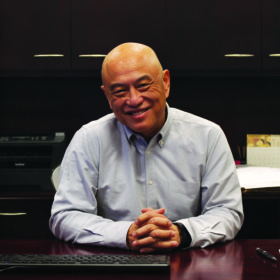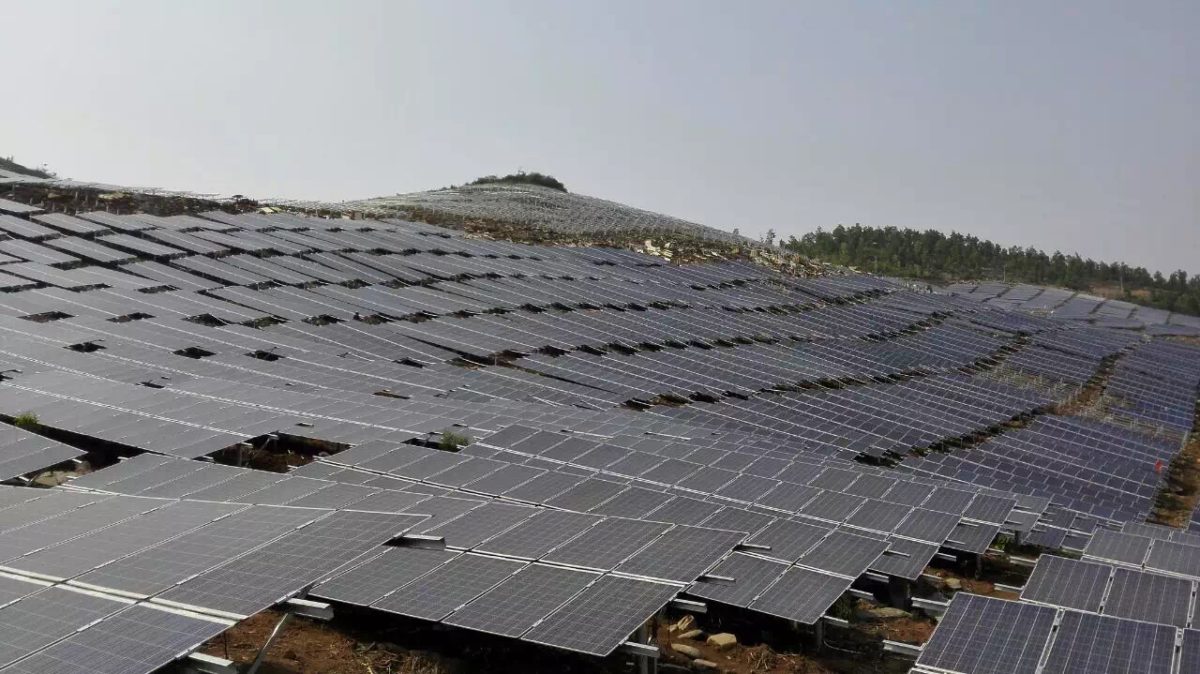Southern California-based SolarMax Technology has turned its attention to China, and now claims to be the largest American-based private company developing PV projects in what has grown to become the world’s biggest solar market.
Having formed wholly-owned subsidiary, SolarMax China in 2015, by acquiring five formerly independent Chinese-based firms, it installed 150 MW of utility-scale PV in the province of Guizhou in 2017. This year, it is planning another 50 MW in Guizhou, in addition to 50 MW in the Ningxia region.

Image: Alexandria Marks
While utility-scale solar is a key focus for the company, Hsu, who emigrated from China to the U.S. in 1983, tells pv magazine it is the residential sector that holds most promise going forward. Below, he discusses SolarMax’s Chinese strategy.
pv magazine: What is it like as a foreign company operating in such a notoriously difficult market?
David Hsu: I emigrated from China in 1983, so I still have resources and connections there; I speak their language and I know their culture. Plus, I think after 30 years, China’s market, culture and way of doing business is getting a lot better. As a matter of fact, a lot of people would rather deal with a company like SolarMax from the U.S., as they believe we are a lot more honest, that we have all the knowledge. It also has a lot to do with our strategy and how we work with the local people.
What strategy are you pursuing in China?
We have a company [SolarMax China] that develops all our projects in China. At the same time, we’re not trying to compete with other companies in China – we’re trying to work and cooperate with them. So as far as project development is concerned, we have a lot of partnerships with both public and state-owned companies over there.
At the same time, we use our product and design knowledge to our advantage. And we also brought O&M [operation and maintenance] ideas. The last 10 years, the Chinese have built a lot of solar farms, but those farms have a lack of maintenance, so the production suffers. Investors complain about production, so we, as a U.S. company, go there and tell them that it’s not just about building a solar farm, you also have to maintain it. We brought the idea of production guarantees from the U.S. to China. It’s a new idea and large companies have embraced it.
A lack of O&M is an issue in China?
A lack of O&M sophistication and support over the last 10 years remains an issue. There are a lot of public companies whose stock is going down and that has a lot to do with the fact the performance of the solar farm is not really there. 24-hour monitoring on these large-scale projects is very important. Of course, at the same time, design factors are key – if you design a system right, the production is going to be better.
The bottom line is that all the issues have to be handled, and costs controlled. Typically, we work with the local people, because they have two advantages: (i) they know the territory; and (ii) their labor is a lot lower than in the big cities. So, we hire local people and train them. At the same time, we subcontract them to clean the solar panels, typically every three or six months.
What are the opportunities and challenges to operating in China versus the U.S., for instance?
It’s a completely different culture. We do a lot of commercial and residential installations in California – it seems, as far as volumes are concerned, that the U.S. volume is relatively lower; however, at the same time there’s a lot more small, independent contracts in the U.S. than in China.
In China, the majority of projects are big and they require a lot more labor. At the same time, as far as policy is concerned, there is much more consistency. It’s kind of strange when you stop to think about it. The Chinese government has had a renewable energy policy for a long time – around 20 years. In the U.S., every time we change president, we have to worry about a new policy. So as far as the development of the U.S. renewable energy market goes, I do have some concerns. As investors, we have to make sure that when we invest the money, we get it back.
What are your specific concerns about the U.S. market?
They just passed the Section 201 tariffs, and now everyone is worried about 2020. The ITC [Investment Tax Credit] is going to raise some issues. Right now, we’re working on commercial projects – we see that the depreciation used to be 30%, and now it’s going to go down to 25%. All the numbers now need to be recalculated. Panel prices have also gone up.
Has SolarMax been affected by the tariffs?
SolarMax is ok, because three years ago we invited one of our partner companies in China [SunSpark Technology Inc.] to open a panel manufacturing factory at SolarMax, here in the city of Riverside. So, now we produce our panels here. As a matter of fact, we have received a lot of phone calls from other companies and manufacturers trying to see if we can manufacture panels for them. There’s a huge demand. It used to be that the panel manufacturers worked eight hours. Now I know they’re planning to work 16 hours, and I think in the near future, it will be 24 hours.
Does SolarMax plan to increase production?
Popular content
If there’s enough demand, definitely. Right now, if we were open 24 hours, we would be producing 150 MW annually. Our SMX-branded panels are made through our OEM partnership with SunSpark.
Coming back to China, SolarMax recently launched a residential rooftop solar program, in cooperation with banks, utilities and the Chinese central government. What prompted the development of this program and what benefits will it bring?
I think the future of the solar in China is the residential market. China has a population of 1.6 billion people. As the government begins to roll out incentive programs to support anti-pollution policy initiatives, you’ll start to see opportunities open up. There’s only so much land over there to build utility-scale solar farms. Once you can’t find the land, then you have to find the roof.
The residential solar sector in China is a little bit different from the one in the U.S., which is focused on individual home installations. In China, it’s a group model. The government also offers a PPA to buy all the electricity back from residential homes – not like the U.S., where you’re using your electricity and only sell excess power back to the utility at an extremely low price. In China, the government offers 20-year PPAs to buy all electricity back from the residential market.
In 2018, SolarMax is planning to finish at least 40 MW of residential solar installations in China. In 2017, we completed our first project, totaling 3 MW, which has already been funded by the bank. On the utility scale side of our portfolio, we’re focusing on three different provinces – Shandong, Guangdong and Guizhou. We just finished a 150 MW project in Guizhou, and we’re going to be doing residential there too.
The utility we’re working with is in the south of China – Southern Power, and there’s three or four different banks with whom we’re dealing, including Huaxia Bank. We financed our initial project with them.
What other locations are of interest to SolarMax?
We are talking about a 50 MW solar installation in Vietnam, but we don’t have anything finalized. I think developing a project in Vietnam has a lot of currency risk.
So far, we’re just listening and continuing to monitor emerging opportunities. We don’t have plans to move into Europe. South America? That may make more sense at some point in the future.
Is SolarMax working on any new technology at the moment?
We’ve been working with the University of California and the U.S. Department of Energy on some advanced micro- and smart grid initiatives. These R&D projects range from small 20 MW micro-grids to 1,000 MW smart grids that not only include solar, but wind, natural gas, and other forms of renewable energy. Our efforts are focused on designing the integrated software system that will link and control each modality across a city or region.
These smart grids serve as another reason why battery storage is a must. In the event of a blackout, between 5-10% of storage capacity is needed to meet demand before the grid comes back online. A lot of companies are going to get into this market during the next three to five years. We’re working on some of those projects now.
What about the Flex Energy Storage System?
Three years ago, we launched our fully integrated, all-in-one-system design technology. Interestingly, we are now getting getting a lot of phone calls from South America, North America, the Middle East, Puerto Rico, Jamaica – I think because of the hurricane. People are thinking about energy storage systems.
Our first-generation FLEX generated a lot of interest and sales for SolarMax in the U.S., as well as overseas. The system was designed for the homeowner that wants peace of mind and protection of their most important appliances and devices during blackouts.
At the same time, we’ve been doing R&D on our second-generation FLEX, a system which includes a number of time-of-use features that gives the consumer more control over their energy use. We expect to roll it out this summer.
What is the storage market like in China?
Right now, in the residential market, I do not think they are focused on storage. As far as commercial and the utility-scale sectors are concerned, however, there’s a lot of discussion and interest in battery storage. How fast that develops will certainly be influenced by the incentives offered by the Chinese government. We believe a number of those programs will emerge this year, once officials agree on key details.
This content is protected by copyright and may not be reused. If you want to cooperate with us and would like to reuse some of our content, please contact: editors@pv-magazine.com.



By submitting this form you agree to pv magazine using your data for the purposes of publishing your comment.
Your personal data will only be disclosed or otherwise transmitted to third parties for the purposes of spam filtering or if this is necessary for technical maintenance of the website. Any other transfer to third parties will not take place unless this is justified on the basis of applicable data protection regulations or if pv magazine is legally obliged to do so.
You may revoke this consent at any time with effect for the future, in which case your personal data will be deleted immediately. Otherwise, your data will be deleted if pv magazine has processed your request or the purpose of data storage is fulfilled.
Further information on data privacy can be found in our Data Protection Policy.